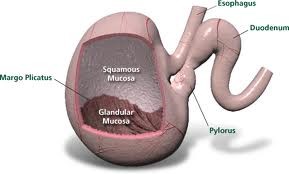Gastroscopy and Equine Gastric Ulcer Syndrome (EGUS)
 Since purchasing our own gastroscope back in October 2017, we have scoped 28 horses here at Summerleaze, and many before that using an external company.
Since purchasing our own gastroscope back in October 2017, we have scoped 28 horses here at Summerleaze, and many before that using an external company.
It is important to know that EGUS is common in all types of horses, and be aware of clinical signs:
- Recurrent low grade colic
- Loss of appetite
- Weight loss
- Lethargy
- Attitude changes and poor performance
- Change in droppings
- Dull coat
The stomach consists of two portions. The upper, squamous (pale pink), and the lower, glandular (purple). Both are susceptible to EGUS, common sites to see ulcers within the stomach are the margo plicatus, lesser curvature and the pylorus.
Causes
- Stress!!! Example of stress for a horse: *long periods of stabling (box rest) *intense/ increased exercise *regular/ prolonged transport *weaning (foal) *management/ housing changes *periods of starvation
- Other factors *low forage/ high concentrate diet *water not readily available *feeding straw
The procedure
The horse is starved overnight to ensure they have an empty stomach in order for us see clearly, they are sedated to allow the passing of a long (3.5 meter!) endoscopic camera up the nose and into the stomach to look for ulceration of the stomach lining following exposure to gastric acid.
Treatment and Prices:
Gastroscope including sedation is £200 including VAT, on a clinic day where we are scoping >1 horse this reduces to £180.
You are looking to be on treatment for approximately 8 weeks, this is variable for each horse taking the severity of ulceration into consideration. You will be encouraged to come back into the clinic for a re scope on week 6 to assess progress.
We recommend staying on our gastric assist supplement for at least a few months following the completion of treatment, and complying with management changes on our fact sheet to prevent recurrence.
Please take a fact sheet for more information or speak to one of our Equine vets
